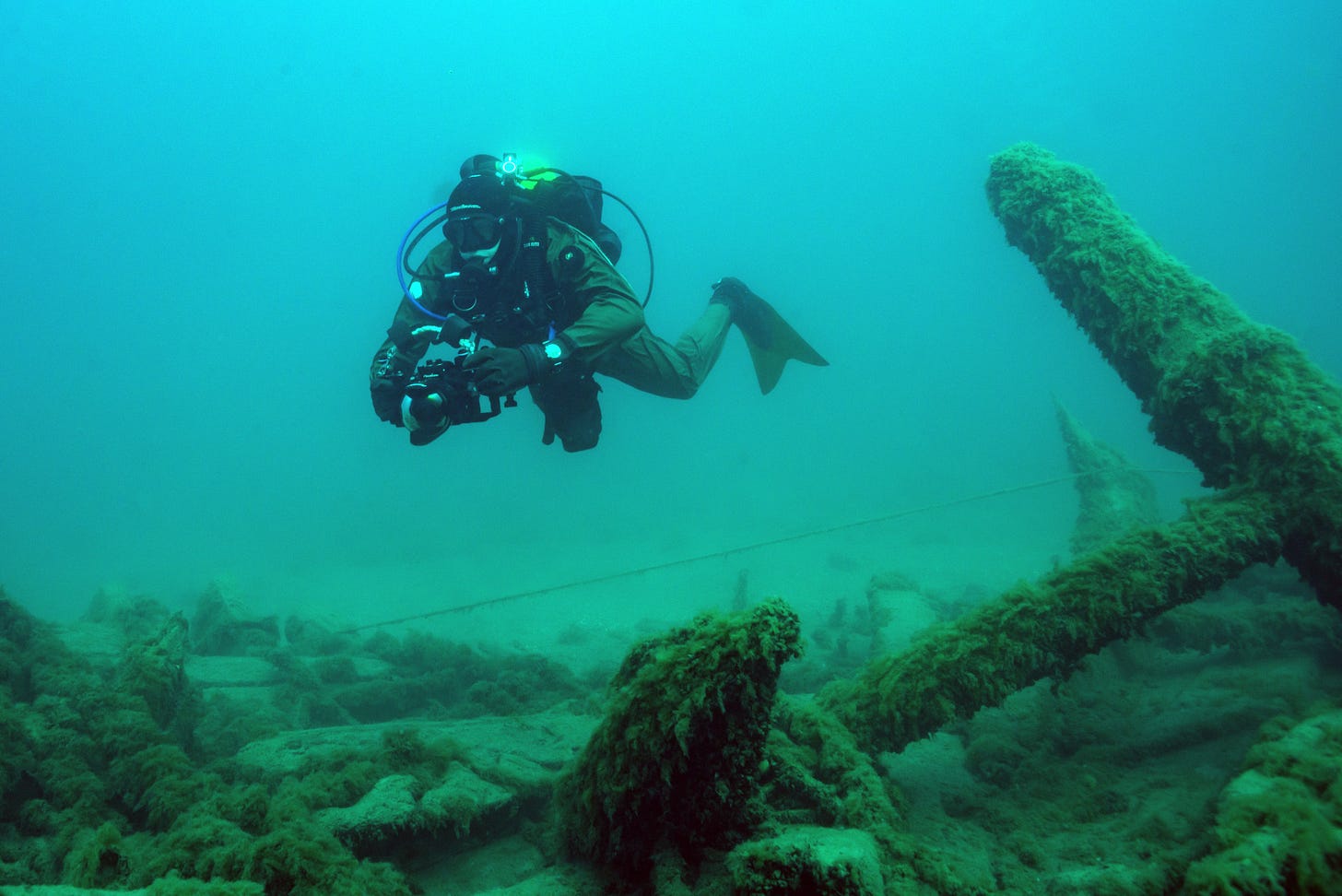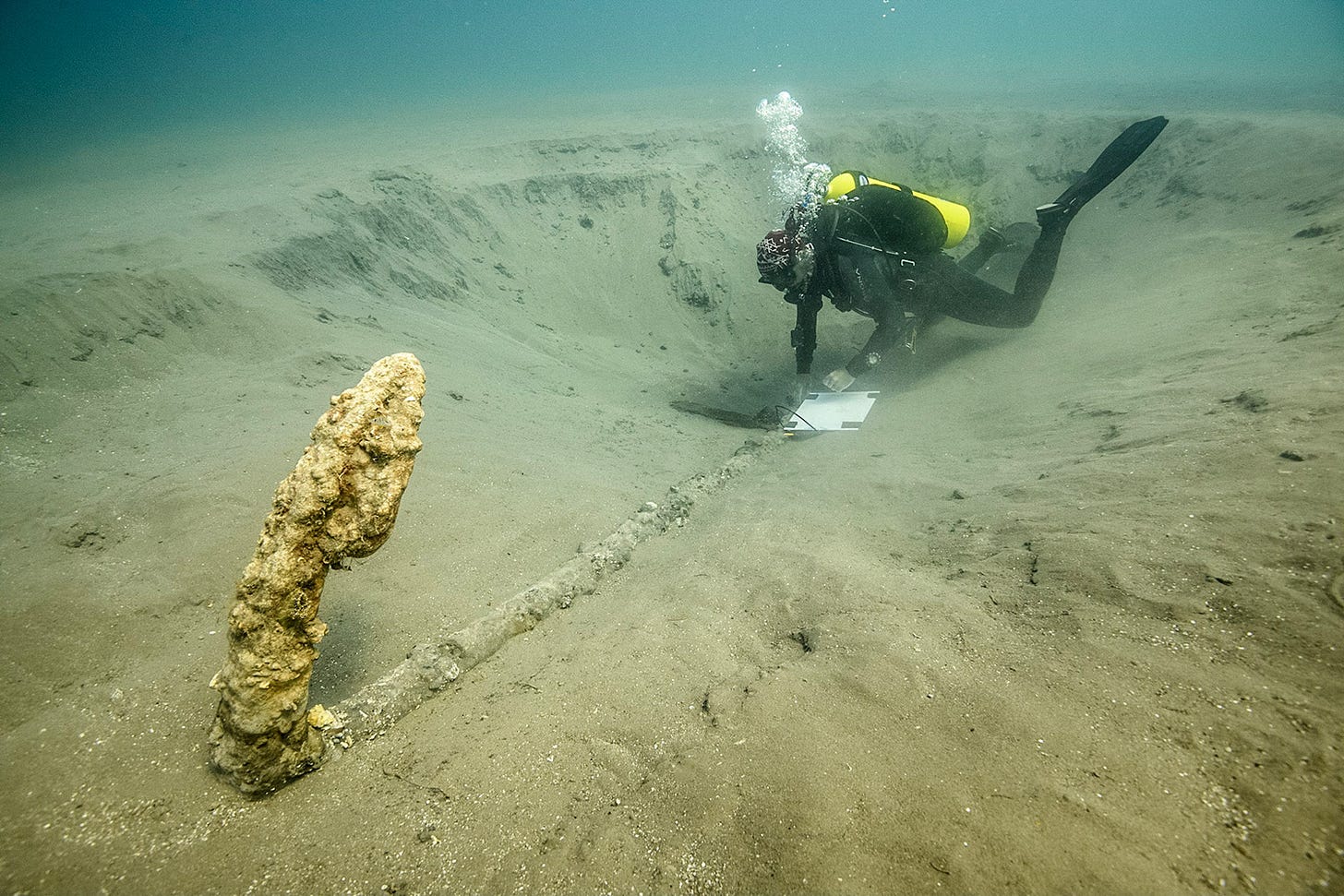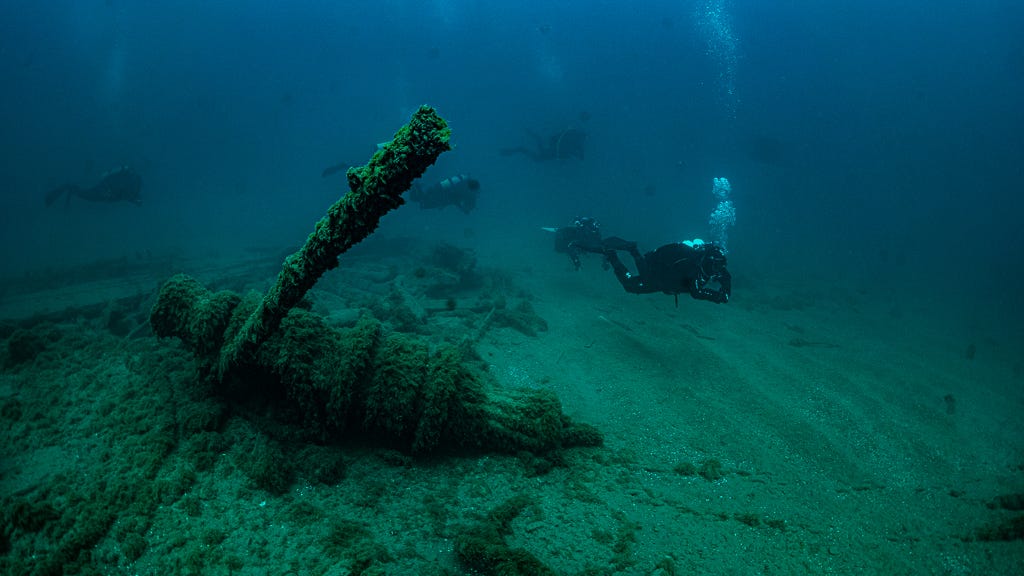Sometimes I feel like I was born at the wrong time. My bookshelf is full of stories about peaks newly climbed, lost civilizations found in the jungle, and shipwrecks discovered. Most of these exploits happened well before I was existed. This is not to say that there aren’t groundbreaking discoveries still being made or first ascents achieved, but nowadays it’s getting harder to pull off, requiring expensive technologies or nuanced versions of what was done in the first half of the twentieth century. Modern exploration lacks the same seat-of-the-pants thrill.
As you know, my area of focus has been scuba diving, with a particular affinity for shipwrecks. And while the vast majority of people will never lay eyes on even the most accessible wrecks that litter the oceans and lakes of the planet, most of the ones I’ve dived have already been found, dived, in some cases picked over, and identified. The one exception to that was my work with the Submerged Archaeological Conservancy International, when I was able to be among the first 20 people to lay eyes on an anchor that is most likely from Hernan Cortes’s fleet that was scuttled offshore near Veracruz in Mexico. We need to get back down there and finish the work to definitively identify the artifacts, but even if it wasn’t from the first European colonizer of Mexico, we were still the first to lay eyes on its 16th century wooden shaft and flukes poking out of the sand.
Little compares with diving a newly discovered shipwreck. The mind reels with the possibilities based on the smattering of clues presented. Three years ago, a dive instructor friend, Chris Scott, sent me some images of a wreck that had been found in the waters of Lake Michigan within sight of Chicago’s skyline. Unbelievably, it lay exposed in about 50 feet of water, with its intact helm (ship’s wheel), a windlass, and anchor jutting up from the mud of the lake bed. It had been found in the summer of 2020, while most of us were locked down at home wearing KN95 masks instead of scuba gear, by Nicole Alarid, a dive charter captain. The discovery, like so many, was made almost by accident, picked up on a side scan sonar sweep while en route to dive another, known wreck. The location was marked and divers returned the next day, astonished at what they found.
Among wreck hunters, GPS coordinates are a closely guarded secret and Nicole, Chris, and the small team that first found it, kept it to themselves as they mapped the wreck and searched for hints as to its identity. I was jealous. More and more wrecks are being found every year but less and less by divers since most lie in water too deep for scuba— Shackleton’s Endurance, the deep World War II wrecks in the Pacific or even some of those in Lake Superior. These discoveries require sonar, magnetometers, ROVs, and submersibles. To swim over the remains of one lying within recreational diving limits was truly a throwback to the days of George Bass’s Byzantine wreck finds, or Luis Marden’s discovery of the Bounty.
A couple of weeks ago, I finally got the chance to dive this “mystery wreck” in Lake Michigan. It was made possible in part, somehow poetically (at least to me), by a watch company, Benrus. They were introducing a new diving watch that was a 1:1 re-issue of one of its 1960s watches, the evocatively named “Ultra-Deep.” Benrus invited a handful of experienced divers to join an early morning charter an hour out of the Hammond, Indiana marina to dive this newly discovered shipwreck while wearing this altogether nostalgic timepiece. The convergence of experiences was not lost on me. A lot of the divers who first found so many wrecks in the 1960s would have relied on watches similar to the Ultra-Deep. With a little imagination, I was transported back to an era before I was born, hovering over a shattered wooden hull littered with dead-eyes (the small devices used to tension sail rigging), while watching the slow march of my watch’s seconds hand time my dive.
The wreck itself is in a fairly sorry state, barely resembling a vessel that once plied the Great Lakes. It looks more like one of those whale carcasses in the deep ocean that has been picked clean by crabs and seven-gill sharks. To the trained eye though, there is the keel, the collapsed hull with its wooden knees, the remains of her masts, and a pile of spilled cargo, iron ore, spread out on the lake bed. There is evidence of the ongoing research work being conducted by the Underwater Archaeological Society of Chicago—yellow numbered survey markers at various spots around the wreck. Absent a definitive clue, such as a ship’s bell with an engraved name, or a builder’s plate, they must rely on other evidence, such as analysis of the iron ore cargo, the wreck’s dimensions, or perhaps the wood itself. A working theory is that it is the remains are those of a schooner called the David A. Wells, that sank in the vicinity in 1880. But I’ll leave that to the experts.
I’ve been engaging in an ongoing conversation with another diver friend (also named Chris) about recovering artifacts from shipwrecks. In those Kodachrome-tinted nostalgic days of the 1950s right up until the ‘90s, it was common practice for divers to bring up items they found on wrecks, everything from portholes to china plates on up to bollards, ship’s wheels, even anchors. Some of these artifacts ended up in museums or on display publicly. A bollard from the Madeira, a wreck I’ve dived many times, sits at the parking lot of the dive entry point and her anchor is on display at the lighthouse nearby that was built in response to the storm that sank her. The whereabouts of the helm or other smaller, more portable items is lost to history though. Nowadays, taking artifacts from a shipwreck is frowned upon, in some cases even illegal. But, like so many arguments, there is no black and white answer. Should these items be left in the deep, for only a few hearty divers to see until they disintegrate, collapse, or rust into oblivion? Or brought up for respectful sharing?
I’ll admit to being disappointed at not being able to see the binnacle or wheel in the pilothouse of the Madeira, or the spittoon in that of the car ferry Milwaukee I also dove last week (with yet another Chris—all my dive buddies seem to be named Chris). But I will also admit to a little jealousy for those who have a porthole or compass or ship’s clock hanging in their home office. Would anyone miss one of those dead-eyes from the Chicago mystery wreck if I had tucked one in my pocket on one of my dives a couple weeks ago? After all, how many people will really get to see the artifacts in situ? Should the aforementioned anchor, wheel, and windlass be salvaged, cleaned up, and put on display in a lakefront park in Chicago or in the Museum of Science and Industry? If they were, the wreck itself would be far less interesting to dive, for sure. I don’t have the answer. It’s easy for armchair explorers and pundits to debate the value or detriment of salvaging (pillaging?) wreck artifacts (booty?).
In the end, it is an ongoing conversation that ultimately needs to decided by those with the most stake in the matter—divers, archaeologists, and, in some cases, the survivors of those who may have perished in some of these wrecks, now grave sites. I will say though, that I count myself as lucky for being able to see this wreck when I did, just as I did that old anchor in Mexico. So maybe I wasn’t born at the wrong time. I just need to dive more. If you have an opinion on the matter, feel free to weigh in.








Like any good debate, I think the answer is it depends. And it begs many questions, whether it's the historical importance of the wreck or condition, for which individual sentiment almost certainly will vary. We have a unique environment in the Lakes that may move those sliders differently from the viewpoint of those in saltwater environments as well.
While I ultimately believe action triumphs over idealism, there is still the very real question of who can claim ownership to these coveted objects. Though these wrecks are not comparable with the significance of the pyramids of Giza or Chichén Itzá, allowing those that are capable of climbing them to remove a piece as a souvenir would forever degrade their importance. In the same way, I don't view someone's conviction and capability as reason enough to lay claim to what I ultimately see as something owned by a people verses a person. Perhaps the best way to ensure that the greatest number of stakeholders are fulfilled is to leave it be. If this is not possible, preservation at a competent local museum (proximity is important contextually) or institution for the greatest number of people to experience. Ultimately, I would agree in principle that an artifact is better served on a diver's wall than reduced to rubble on the sea floor.
Admittedly I am somewhere between the armchair and explorer you mention here, surrounding myself with literature and objects in my basement while not capable enough a diver to visit most of these artifacts where they lay. Maybe I'm even a hypocrite, though no object I own is from a shipwreck. But it's all catapulted me into a nearly life-long obsession with the history of these lakes, even motivating me to pursue some of the high-stakes categories you've listed above. And while I can't claim to have earned true membership into any of those categories, I contend that those that call (or called) home the regions and ports of these wrecks have as much to gain and even more to lose by what is taken or left beneath the waves.
Jason said “booty”... 😋